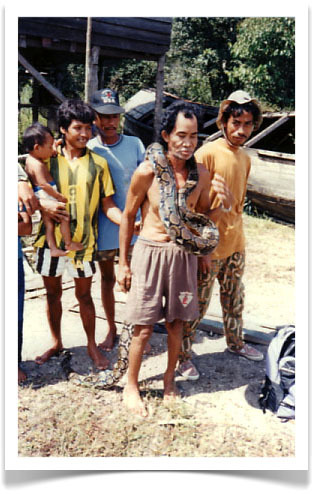 Danau Sentarum National Park (DSNP), Kapuas Hulu, West Kalimantan, Indonesia. The park is a series of interconnected seasonal lakes in the floodplain of the upper Kapuas River.
Danau Sentarum National Park (DSNP), Kapuas Hulu, West Kalimantan, Indonesia. The park is a series of interconnected seasonal lakes in the floodplain of the upper Kapuas River.
 The village of Pulau Majang in DSNP. All of the pilings, boardwalks, railings, and stairs are made from Fragraea fragrans (Loganiaceae). [NOTE: Both images have been scanned from slides.]
The village of Pulau Majang in DSNP. All of the pilings, boardwalks, railings, and stairs are made from Fragraea fragrans (Loganiaceae). [NOTE: Both images have been scanned from slides.]
Danau Sentarum is the largest inland lake on the island of Borneo. The lake supports a large traditional fishing industry and is home to 39 fishing villages. During the flooding season, water levels can rise to within inches of the boardwalks and floors of the houses, completely surrounding the community and making it look like the entire village is floating on the lake.
I spent a pleasant evening in Pulau Majang during the floodpeak of 1993 and was impressed by the skill with which everyone navigated the narrow wooden boardwalks in the dark. One wrong step and you end up in the lake. I was a bit concerned about all of the little kids scurrying around. In response to my question about whether any children had ever fallen off, I was told, "Oh, yeah. They all do. But you pull them out and they never do it again." A key lesson, I guess, if you are living over a 30,000 hectare lake. Click here for more information about what I was working on at DSNP.
 Monday, July 20, 2015 at 9:42AM
Monday, July 20, 2015 at 9:42AM 











